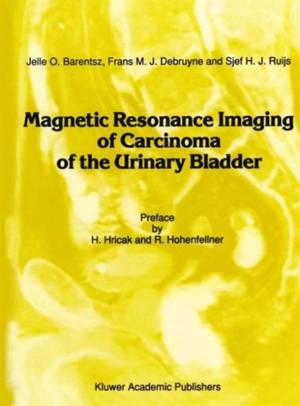
- Afhalen na 1 uur in een winkel met voorraad
- Gratis thuislevering in België vanaf € 30
- Ruim aanbod met 7 miljoen producten
- Afhalen na 1 uur in een winkel met voorraad
- Gratis thuislevering in België vanaf € 30
- Ruim aanbod met 7 miljoen producten
Zoeken
Magnetic Resonance Imaging of Carcinoma of the Urinary Bladder
Jelle O Barentsz, Frans M J Debruyne, J H J Ruijs
€ 100,95
+ 201 punten
Uitvoering
Omschrijving
Carcinoma of the urinary bladder is a common (in the USA it is the fifth most common form of cancer in males and tenth most common form of cancer in females) malignan- cy and one in which noninvasive staging by imaging plays such an important role. This book presents a complete approach to MR imaging of carcinoma of the urinary bladder from a detailed discussion of the value of MRI in the diagnosis of the urinary bladder to the history of the procedure. The technical discussion of the general principles of MRI including the optimal pulse sequences to be used and factors that influence the quality of images are included in this book. The safety factors are also presented along with contraindications. The application of a double surface coil with the field strength of O.5T provides the fine quality of the illustrations. The atlas of comparative anatomy by MRI on normal volunteers and post-mo'rtem specimens as well as MR images on patients with bladder tumors and post-surgery specimens is unique. The results of the clinical imaging stu- dies in patients with carcinoma of the bladder, comparing the relative value of clinical staging, MR, CT and lymphography, are helpful in showing the advantages of MRI.
Specificaties
Betrokkenen
- Auteur(s):
- Uitgeverij:
Inhoud
- Aantal bladzijden:
- 136
- Taal:
- Engels
- Reeks:
- Reeksnummer:
- nr. 21
Eigenschappen
- Productcode (EAN):
- 9780792308386
- Verschijningsdatum:
- 31/08/1990
- Uitvoering:
- Hardcover
- Formaat:
- Genaaid
- Gewicht:
- 699 g

Alleen bij Standaard Boekhandel
+ 201 punten op je klantenkaart van Standaard Boekhandel
Beoordelingen
We publiceren alleen reviews die voldoen aan de voorwaarden voor reviews. Bekijk onze voorwaarden voor reviews.








